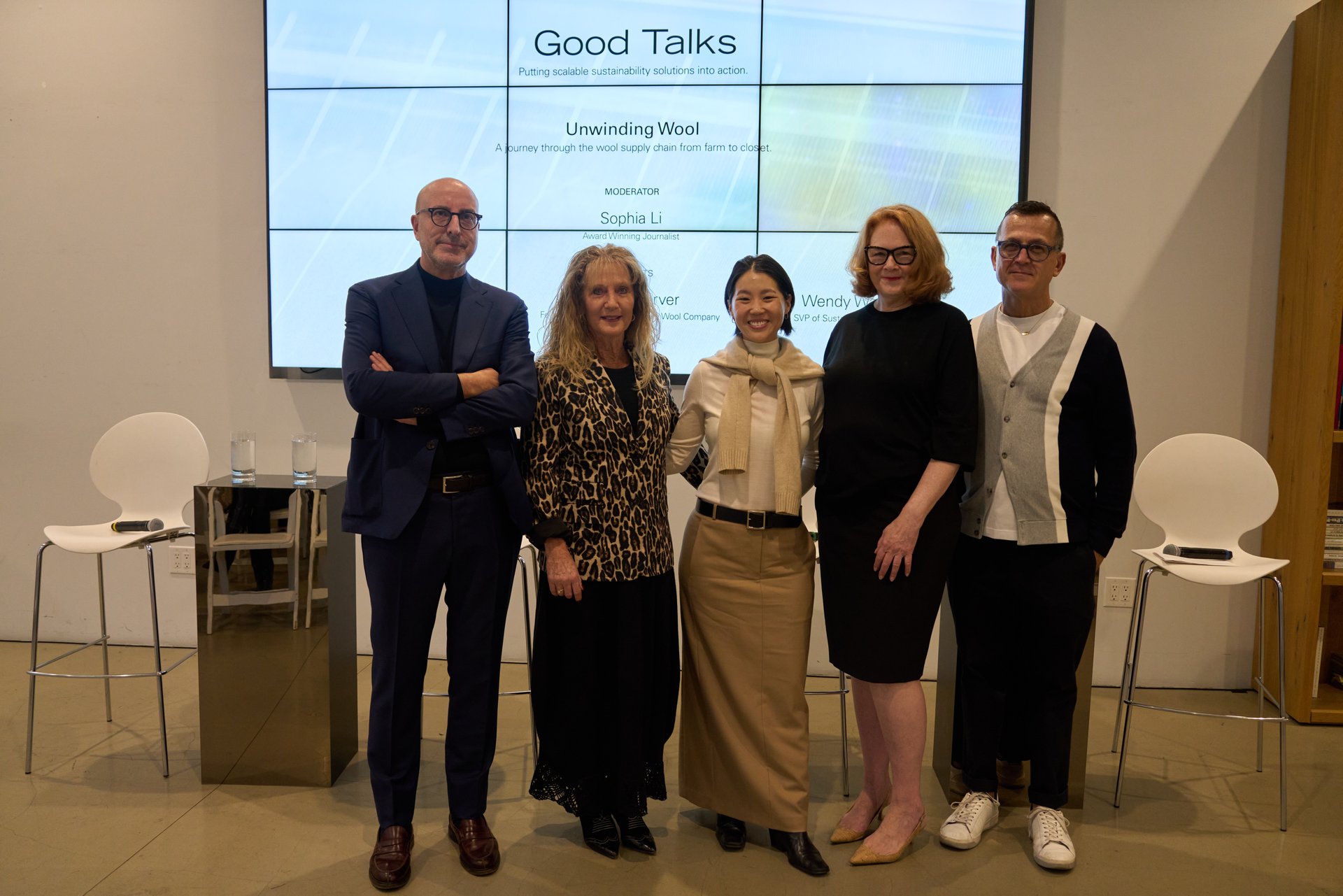On Thursday, October 24 the CFDA and Theory hosted the third and final session of the 2024 Good Talk series, “Unwinding Wool.” To kick-off this session, moderator Sophia Li began with a breathing exercise to reset participants’ minds.
The panel featured Silvio Botto, CEO of Botto Giuseppe; Jeanne Carver, Founder & President of Shaniko Wool Company, and Wendy Waugh, SVP of Sustainability at Theory. Together, they guided fashion leaders, educators, and activists through the wool supply chain, from farm to closet.
The discussion highlighted that true change requires confronting uncomfortable truths. It emphasized that sustainability goes beyond materials and processes; it requires focusing on awareness, compassion, and accountability. The conversation invited reflection on the wool supply chain and the broader challenge of building a more conscious fashion industry, leaving participants inspired to continue these important discussions.
Here, highlights from the conversation.
Where do you think the fashion industry stands today? How can we balance environmental responsibility with profitability?
Wendy Waugh: We are at a point where we recognize that change is necessary. Some companies have been on this path for a while, but the industry – as a whole – needs to evolve. The real question is: how? It is a time of opportunity and innovation. It will not be easy, there will be challenges, limitations, and plenty of reasons why things cannot be done a certain way. But I believe we can work through those obstacles together.
Jeanne Carver: Historically, people relied on local and regional supply systems for essentials like food, clothing, and shelter. As populations grew, we became more specialized and disconnected, leading to a massive shift. Now, we need to reclaim the essential practices that once sustained us.
Even though we have become highly specialized and separated, it is crucial to reintegrate those valuable elements. We are facing the challenge of turning a massive, disconnected system. We must invest in the environment.
Silvio Botto: The fashion industry is one of the most polluting, second only to oil and energy. While water usage has dropped from 20% to 10%, the rapid growth of fashion in the last 20 years has strained the planet. Fast fashion relies on low-cost and poor-quality materials that do not degrade and release microfibers during washing, which adds to pollution.
Brands have the power to drive change by educating consumers, who should buy less but choose higher-quality items. Designers also play a key role, as 80% of a product’s environmental impact comes from their material and quality decisions. Industry collaboration is essential for sustainability, but true progress starts with changing the consumers mindset.
Why do you think the existence of American wool is often overlooked?
Jeanne Carver: American wool has become nearly invisible. Textiles and clothing once helped build the country, but production began shifting abroad in the 1980s and 1990s.
Today, the U.S. retains less than 10% of its former textile manufacturing infrastructure. This decline mirrored a collapse in the sheep industry, with 26,000 producers going out of business between 1996 and 2000 as wool lost value and buyers disappeared.
Globalization disrupted these long-standing connections, harming both wool and sheep farming. As production dwindled, wool producers became irrelevant, with fewer people recognizing the industry’s value.
Can you explain Cradle to Cradle, and why it was important to embed those principles as a supplier?
Silvio Botto: Our 2016 collection, Natural Paper, featured renewable fibers like wool, cashmere, and silk. Cradle to Cradle certification evaluates every step of the supply chain and emphasizes waste reduction. Even production waste is reused, such as blending recycled and virgin cashmere for GRS-certified yarn.
The certification focuses on five areas: materials, animal welfare, people, environment, and product circularity. Products must be reused or recycled, and studies show wool can be recycled up to six times. We foster awareness by hosting open days, inviting students to explore our work firsthand.
Why is it so challenging for brands to communicate where materials come from? Why is traceability of raw materials so important?
Wendy Waugh: Traceability is essential for brands to take responsibility for their impact. To reduce CO2 and GHG emissions, we need a clear view of the supply chain. This can be difficult since traditional mills collect fibers from multiple farms, making it hard to trace each lot. Since 2017, we have built strong relationships with core suppliers, including our supplier, to understand where materials come from.
Progress has been slow but steady, and the more I learn, the more passionate I become about knowing everyone in our supply chain. Collaboration is key, identifying every player in the supply chain is the first step. Invisibility is not acceptable.
Why was regenerating the land important?
Jeanne Carver: 25 years ago, wool was sold by the pound, with farmers taking whatever price was offered. They are price takers, not price makers, relying on what buyers will give after each shearing, despite wool being a renewable fiber used for over 10,000 years.
Wool is the original performance fiber and far removed from the industry. But it is promising to see brands returning. This fiber was created with purpose and it is hard to improve on that. Each step in the supply chain adds margins, making it difficult for farmers to capture much value.
What is the next step to move forward?
Jeanne Carver: There is growing concern about the environment, health, and climate. In 2019, a brand questioned whether raising livestock was harming the earth, given its poor reputation.
To address this, we rely on observations, species counts, yield data, agency testimony, and annual audits against 275 criteria under the RWS standard. We are also certified as regenerative. Understanding the impact of our farming and ranching practices is essential.



